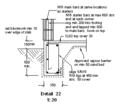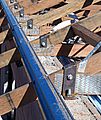Hurricane-proof building: Difference between revisions
Undid revision 661305718 by 47.17.255.33 (talk) |
|||
| Line 32: | Line 32: | ||
====Doors==== |
====Doors==== |
||
Doors can be blown into the house by wind causing |
Doors can be blown into the house by wind causing potential [[structural failure]]. Some doors can resist high winds{{citation needed|date=February 2013}} |
||
====Windows==== |
====Windows==== |
||
Revision as of 21:25, 12 May 2015
Tornadoes, cyclones, and other storms with strong winds damage or destroy many buildings. However, with proper design and construction, the damage to buildings by these forces can be greatly reduced. A variety of methods can help a building survive strong winds and storm surge.
Storm surge considerations
Waves along coastal areas can destroy a building. Buildings should preferably be built on high ground in order to avoid waves. If waves can reach the building site, the building ought to be elevated on steel, concrete, or wooden pilings or anchored to solid rock.
Wind loading considerations
The foundation

Wind acting on the roof surfaces of a building can cause negative pressures that create a lifting force sufficient to lift the roof off the building. Once this occurs, the building is weakened considerably and the rest of the building will likely fail as well. To minimize this vulnerability, the upper structure ought to be anchored through the walls to the foundation.
Several methods can be used to anchor the roof. Typically, roof trusses are "toenailed" into the top of the walls, which provide insufficient force to resist high winds. Hurricane ties nail into the wall and wrap over the trusses provide higher force resistance.
Mobile home tie down to the foundation
Interlocking metal pan roof systems installed on mobile homes can fail under the pressure differential (lift) created by the high velocity winds passing over the surface plane of the roof. This is compounded by the wind entering the building allowing the building interior to pressurize lifting the underside of the roof panels, resulting in destruction of the building. One example of pan roof systems can be found in this document from Structall Building Systems.
To mitigate this pressure differential, pre-installed aluminum tabular channels can permanently be fastened perpendicularly across the top of the interlocking ribs of the metal roof system without disturbing the flow of rainwater at the eaves, mid-span, and ridge locations of the building.
Earth sheltering
Earth sheltered construction is generally more resistant to strong winds and tornadoes than standard construction. Cellars and other earth sheltered components of other buildings, can provide safe refuge during tornadoes.
Dome homes
The physical geometry of a building affects its aerodynamic properties and how well it can withstand a storm. Geodesic dome roofs or buildings have low drag coefficients and can withstand higher wind forces than a square building of the same area.[1][2] Even stronger buildings result from monolithic dome construction.[3]
Building components
Openings
Building openings such as garage doors and windows are often weak points susceptible to failure by wind pressure and blowing debris. Once failure occurs, wind pressure builds up inside the building resulting in the roof lifting off the building. Hurricane shutters can provide protection.
Doors
Doors can be blown into the house by wind causing potential structural failure. Some doors can resist high winds[citation needed]
Windows
Windows can be constructed with plastic panes, shatter-proof glass, or glass with protective membranes. The panes are often more firmly attached than normal window panes, including using screws or bolts through the edges of larger panes. Tapcons are used to fasten windows with the concrete structure surrounding.
Wood
Wood has a relatively high degree of flexibility which can be beneficial under certain building stresses.
Concrete
Reinforced concrete is a strong, dense material that, if used in a building, such as Nelson tower in Austin,TX, that is designed properly, can withstand the destructive power of very high winds, and high-speed debris.
Regulation
Hong Kong requires many structures to withstand winds from typhoons.[4]
Examples of cyclonic construction methods
Residential construction in Darwin Northern Australia
-
Starter bars cast into concrete slab for blockwork wall reinforcing,
-
Detail of reinforcing steel at edge of concrete raft slab
-
16mm Cast in hold down bolts. 150 to 300 long cast into blockwork bond beams
-
HD bolt to truss connection. also seen, metal roof batten fixing, speedbrace end fixing.
-
Typical roof member connector straps.
-
Internal mig welded shearwalls
-
Shearwall to slab connection, M12 chemsets through 6 plate washers, typ. at ends and 900ctrs.
-
Sketch of 200 series reinforced blockwork fence wall. Terrain category 3 (close to sea front)
-
Sketch of typical foundation layout for sloping ground.
See also
- Bubble Houses (Hobe Sound, Florida)
- Dymaxion house
- Hurricane preparedness
- HurriQuake nail (for resisting hurricanes and earthquakes)
- Structural design
- Structural engineering
- Windstorm inspection
References
Notes
- ^ http://www.stanford.edu/~scheulen/.../StructuralMechanicsFinalReport.pdf
- ^ http://www.ewb-uk.org/system/files/Marek+Kubik+report.pdf
- ^ http://www.monolithic.com/stories/building-survivability-the-strength-of-the-monolithic-dome
- ^ Phil Muncaster (September 30, 2013). "Hong Kong's data centres stay high and dry amid Typhoon Usagi". The Register. Retrieved January 5, 2015.
This article needs additional citations for verification. (January 2008) |









